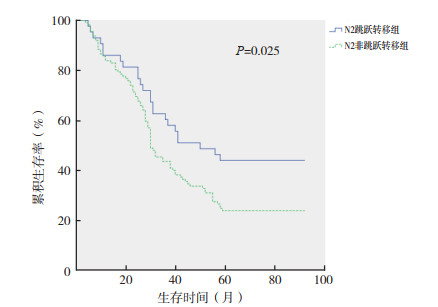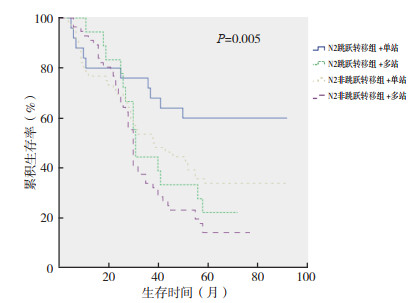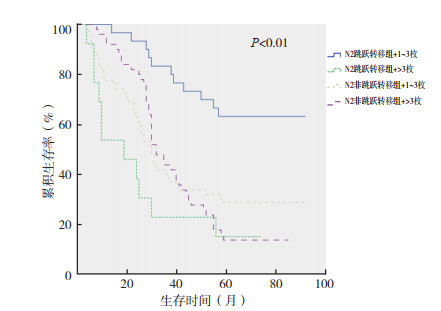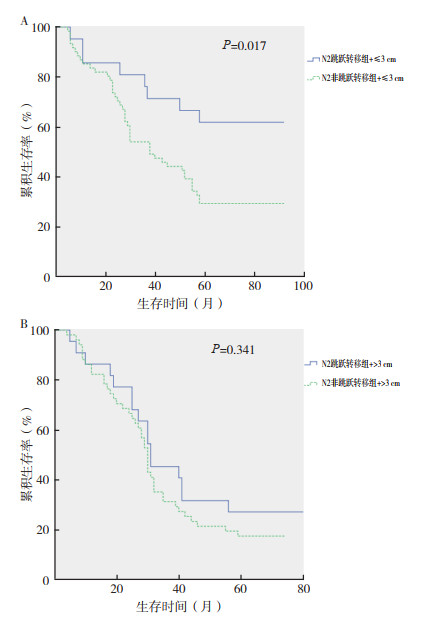文章信息
- 谭林, 梁效民, 王琛, 郝万明, 王东飞
- Tan Lin, Liang Xiaomin, Wang Chen, Hao Wanming, Wang Dongfei
- ⅢA-N2期非小细胞肺癌N2淋巴结跳跃转移的临床分析
- Clinical analysis of N2 skip metastases in stage ⅢA-N2 non-small-cell lung cancer
- 实用肿瘤杂志, 2020, 35(6): 501-505
- Journal of Practical Oncology, 2020, 35(6): 501-505
基金项目
- 山东省医药卫生科技发展计划项目(2017WS309)
-
作者简介
- 谭林(1983-),男,山东青岛人,主治医师,硕士生,从事胸外科基础及临床研究.
-
通信作者
- 梁效民,E-mail:18653238866@wo.cn
-
文章历史
- 收稿日期:2020-03-10
2. 青岛市市立医院重症医学科,山东 青岛 266071;
3. 青岛市市立医院呼吸与危重症医学科,山东 青岛 266071
2. Department of Critical Care Medicine, Qingdao Municipal Hospital, Qingdao 266071, China;
3. Department of Respiratory and Critical Medicine, Qingdao Municipal Hospital, Qingdao 266071, China
肺癌是世界上高发病率和高死亡率的恶性肿瘤之一[1],其中ⅢA-N2期非小细胞肺癌(non-small-cell lung cancer, NSCLC)约占NSCLC的20%[2],因伴有N2淋巴结转移,其复发和转移风险较高,且预后差异较大,是近年来的研究热点。目前,常见的N2淋巴结转移方式为淋巴转移途径肺内、肺门淋巴结至纵隔淋巴结(pN1N2;Non-skip N2);但当患者仅有纵隔淋巴结转移而无肺内及肺门淋巴结转移时,称为跳跃转移(pN0N2;Skip N2)[3]。本研究回顾性分析本院收治的155例ⅢA-N2期NSCLC患者的临床资料,探讨N2跳跃转移与ⅢA-N2期NSCLC各临床病理特征和生存的关系。
1 资料与方法 1.1 一般资料收集本院2006年1月至2013年12月收治的ⅢA-N2期NSCLC患者共155例,纳入标准:(1)按第8版TNM分期标准[4],术后病理证实为ⅢA-N2期NSCLC;(2)接受肺癌根治性手术(肺叶切除、联合肺叶切除、肺叶袖式切除及全肺切除+纵隔淋巴结清扫术);(3)术前评估无远处转移;(4)术前未行化疗和放疗等辅助治疗,术后行4个周期化疗(含铂类两药化疗)。排除标准:(1)围手术期发生死亡;(2)既往有其他恶性肿瘤病史;(3)合并有其他严重疾病(严重的心脑血管病等)。根据纳入及排除标准,本研究共入组155例ⅢA-N2期NSCLC患者。其中吸烟者89例,不吸烟者66例;男性99例,女性56例;年龄42~85岁,平均年龄62.5岁,≤65岁91例,> 65岁64例;左肺57例,右肺98例;鳞癌42例,腺癌89例,其他类型24例;脉管内无癌栓107例,有癌栓48例;肿瘤大小≤3 cm者82例,> 3 cm者73例;N2阳性淋巴结单站转移81例,多站转移74例;N2阳性淋巴结数目1~3枚92例,> 3枚63例;N2淋巴结跳跃转移43例(N2跳跃转移组),无跳跃转移112例(N2非跳跃转移组)。
1.2 随访随访截止至2018年12月30日,随访方式有住院、门诊和电话等方式,随访内容包括术后辅助治疗方式、肿瘤有无复发和转移以及患者的死亡日期等。
1.3 统计学分析采用SPSS19.0软件进行统计学分析。分类计数采用四格表χ2检验。Kaplan-Meier法分析患者术后生存情况。Log-rank检验各变量与预后的关系。多因素分析采用Cox模型。以P < 0.05为差异具有统计学意义。
2 结果 2.1 N2淋巴结跳跃转移与临床病理特征相关性分析ⅢA-N2期NSCLC患者N2淋巴结跳跃转移与吸烟、性别、年龄、肿瘤位置、肿瘤大小和脉管癌栓无关(均P > 0.05);而与病理类型相关(χ2=7.974,P=0.019;表 1)。
| 临床病理特征 | 例数 | N2跳跃转移组(n=43) | N2非跳跃转移组(n=112) | χ2值 | P值 |
| 吸烟 | 0.702 | 0.402 | |||
| 是 | 89 | 27 | 62 | ||
| 否 | 66 | 16 | 50 | ||
| 性别 | 0.040 | 0.841 | |||
| 男性 | 99 | 28 | 71 | ||
| 女性 | 56 | 15 | 41 | ||
| 年龄 | 0.409 | 0.523 | |||
| ≤65岁 | 91 | 27 | 64 | ||
| > 65岁 | 64 | 16 | 48 | ||
| 肿瘤位置 | 1.095 | 0.295 | |||
| 右肺 | 98 | 30 | 68 | ||
| 左肺 | 57 | 13 | 44 | ||
| 病理类型 | 7.974 | 0.019 | |||
| 鳞癌 | 42 | 18 | 24 | ||
| 腺癌 | 89 | 22 | 67 | ||
| 其他 | 24 | 3 | 21 | ||
| 脉管癌栓 | 1.445 | 0.229 | |||
| 无 | 107 | 32 | 72 | ||
| 有 | 48 | 11 | 40 | ||
| 肿瘤大小 | 0.395 | 0.530 | |||
| ≤3 cm | 82 | 21 | 61 | ||
| > 3 cm | 73 | 22 | 51 |
N2跳跃转移组的生存情况优于N2非跳跃转移组(5年生存率:44.2% vs 24.1%,χ2=5.046,P=0.025;中位无瘤生存期:41个月vs 29个月,χ2=4.127,P=0.042;图 1)。对其他临床因素单因素分析显示,N2阳性淋巴结转移站数(χ2=8.407,P=0.004)、N2阳性淋巴结数目(χ2=8.000,P=0.005)和肿瘤大小(χ2=6.519,P=0.011)与ⅢA-N2期NSCLC患者的远期生存率均有关,而与吸烟、性别、年龄、肿瘤位置和病理类型无关(均P > 0.05)。将单因素分析有意义的变量因素导入多因素分析,结果显示,跳跃转移及肿瘤大小为患者术后生存时间的独立影响因素(P=0.047;P=0.038;表 2);在亚组分析中,跳跃转移并N2阳性淋巴结单站转移(χ2=12.674,P=0.005;图 2)、N2阳性淋巴结数目≤3枚(χ2=20.281,P < 0.01;图 3)及肿瘤大小≤3 cm(χ2=5.661,P=0.017;图 4)的ⅢA-N2期NSCLC患者,术后生存时间长。

|
| 图 1 N2跳跃转移组和N2非跳跃转移组非小细胞肺癌患者总生存曲线 Fig.1 Overall survival curves of NSCLC patients in the N2 skip and non-skip metastasis groups |
| 临床因素 | B | SE | Wald | df | RR(95%CI) | P值 |
| N2阳性淋巴结转移站数(单站/多站) | -0.383 | 0.247 | 2.396 | 1 | 0.682(0.420~1.107) | 0.122 |
| N2阳性淋巴结数目(1~3枚/ > 3枚) | -0.128 | 0.252 | 0.259 | 1 | 0.880(0.537~1.442) | 0.611 |
| 肿瘤大小(≤3 cm/ > 3 cm) | -0.413 | 0.199 | 4.309 | 1 | 0.662(0.448~0.977) | 0.038 |
| 跳跃转移(有/无) | -0.473 | 0.238 | 3.953 | 1 | 0.623(0.391~0.993) | 0.047 |

|
| 图 2 N2跳跃转移组和N2非跳跃转移组中淋巴结转移站数亚组总生存曲线 Fig.2 Effect of the number of lymph node metastasis stations on overall survival in the N2 skip and non-skip metastasis groups |

|
| 图 3 N2跳跃转移组和N2非跳跃转移组淋巴结转移数目亚组总生存曲线 Fig.3 Effect of the number of lymph node metastasis on overall survival in the N2 skip and non-skip metastasis groups |

|
| 注 A:肿瘤≤3 cm患者总生存曲线;B:肿瘤 > 3 cm患者总生存曲线 图 4 N2跳跃转移组和N2非跳跃转移组肿瘤大小亚组总生存曲线 Fig.4 Overall survival curves of patients with tumor size (≤3 cm or > 3 cm) in the N2 skip and non-skip metastasis groups |
既往研究结果显示,N2淋巴结跳跃转移发生率约为20%~40%[5-7]。常规的淋巴结转移是通过肺内-肺门-纵隔这一途径,但也有可能通过胸膜下淋巴管回流,并且不同肺叶的淋巴回流途径可能不同,这些肺叶与纵隔淋巴结之间的多个回流通路,造成N2淋巴结跳跃转移的发生[8]。研究显示,85例ⅢA-N2期NSCLC患者N2淋巴结跳跃转移发生率为25%;在鳞癌中的发生率为46%,高于其他类型的发生率[9]。本研究中N2淋巴结跳跃转移的发生率为27.7%,与既往的报道数据大致相符[9];但各个研究中报道的N2淋巴结跳跃转移发生率差别较大,可能与肺的解剖因素及手术操作因素等有关。肺门淋巴结可能存在微转移灶,但病理切片对于微转移灶可能漏检,造成肺门淋巴结的假阴性;另外,手术时对于淋巴结的清扫程度及范围也决定其检出率。本研究中肺鳞癌患者是最易发生跳跃转移的病理类型(鳞癌为42.9%,腺癌为24.7%,其他为12.5%;χ2=7.974,P=0.019);与相关研究报道相符[10]。但跳跃转移与病理类型的相关性仍有争议。有学者认为鳞癌多起源于较大的气管,可能有更多的淋巴通路直至纵隔,更易发生跳跃转移[11];也有研究认为腺癌更易发生跳跃转移[12];但也有学者认为跳跃转移与病理类型无关,而与肿瘤细胞及淋巴结的生物学特性有关[13]。因此,跳跃转移与鳞癌的相关性还有待进一步研究。
有研究根据患者是否跳跃转移和N2阳性淋巴结转移站数,将N2期患者分为四组(Skip-single station组、Skip-multiple station组、Nonskip-single station组和Nonskip-multiple station组),Skip-single station组的预后最好(5年生存率为36.3%),Skip-multiple station组(27.8%)和Non skip-single station组(26.3%)的预后次之,Non skip-multiple station组(14.3%)的预后最差,差异具有统计学意义(P < 0.01)[14]。本研究亚组分析结果与其一致,N2跳跃转移组有58.1%为单站转移,该亚组5年生存率最高(χ2=12.208,P=0.007)。可以得出结论:N2淋巴结跳跃转移中单站转移患者比多站转移多,所以N2淋巴结跳跃转移的患者预后更好,并且是独立的影响因素(P < 0.05)。Yazgan等[15]和Li等[10]的研究也显示,跳跃转移多为纵隔淋巴结单站转移,转移站数少是患者预后较好的重要原因,与本研究的结果相符。该结果支持第8版TNM分期[4],将N2进一步分为N2a1(skip single station involved)、N2a2(non-skip single station involved)和N2b(multiple station involved),N2a1期的患者具有更好的预后。
研究显示,跳跃转移组的ⅢA-N2期NSCLC患者N2阳性淋巴结数目少于非跳跃转移组[(2.0±1.6)个vs(6.9±5.1)个,P < 0.01),5年生存率跳跃转移组患者高于非跳跃转移组(55.4% vs 30.8%,P=0.04)[16]。通过对478例ⅢA-N2期NSCLC患者的研究显示,跳跃转移并纵隔阳性淋巴结仅1个的亚组,生存情况优于其他亚组(P=0.003)[17]。以上2项研究均提示与非跳跃转移组比较,跳跃转移组的纵隔淋巴结阳性数较少,这应该是跳跃转移组预后较好的原因。本研究根据患者是否跳跃转移和N2阳性淋巴结数目进行亚组分析,结果显示,N2跳跃转移组69.8%的患者纵隔淋巴结转移数目≤3枚,该亚组5年生存率高于其他亚组(χ2=20.281,P < 0.01)。该结果与以上研究的结果一致[16-17]。
第8版肺癌分期更加重视原发肿瘤大小对预后的影响,在所有的T分类中均加入肿瘤大小的因素[18]。本研究中肿瘤大小为患者术后生存时间的独立影响因素(P < 0.05)。Wang等[11]通过亚组分析显示,当肿瘤大小≤3 cm时,跳跃转移组患者5年生存率高于非跳跃转移组(60.7% vs 36.5%,P=0.014),而当肿瘤大小 > 3 cm时,两组患者生存比较,差异无统计学意义(P=0.193),本研究结果与此一致,考虑当肿瘤较大时,肿瘤负荷大,无论是否发生N2淋巴结跳跃转移,患者的预后均较差。
综上所述,N2淋巴结跳跃转移可以作为独立的预后因素;发生跳跃转移的患者,多为N2淋巴结单站转移及更少的N2阳性淋巴结数目,具有良好的生存率。对于肿瘤较小的周围型肺癌患者,即使肺门淋巴结为阴性,仍有发生跳跃转移的可能,术中应行系统性纵隔淋巴结清扫。
| [1] |
凌发昱, 喻东亮. 局部晚期肺癌扩大切除的外科治疗现状[J]. 实用肿瘤杂志, 2018, 33(5): 476-479. |
| [2] |
Detterbeck FC, Boffa DJ, et al. The new lung cancer staging system[J]. Chest, 2009, 136(8): 260-271. |
| [3] |
Libshitz HI, McKenna RJ, Mountain CF, et al. Patterns of mediastinal metastases in bronchogenic carcinoma[J]. Chest, 1986, 90(2): 229-232. DOI:10.1378/chest.90.2.229 |
| [4] |
叶波, 赵珩. 第八版国际肺癌TNM分期修订稿解读[J]. 中国肺癌杂志, 2016, 19(6): 337-342. |
| [5] |
Bonner JA, Garces YI, Sawyer TE, et al. Frequency of noncontiguous lymph node involvement in patients with resectable non-small-cell lung carcinoma[J]. Cancer, 1999, 86(7): 1159-1164. DOI:10.1002/(SICI)1097-0142(19991001)86:7<1159::AID-CNCR9>3.0.CO;2-K |
| [6] |
Gorai A, Sakao Y, Kuroda H, et al. The clinicopathological features associated with skip N2 metastases in patients with clinical stage ⅠA non-small-cell lung cancer[J]. Eur J Cardiothorac Surg, 2015, 47(4): 653-658. DOI:10.1093/ejcts/ezu244 |
| [7] |
Guerrera F, Renaud S, Tabbo F, et al. Epidermal growth factor receptor mutations are linked to skip N2 lymph node metastasis in resected non-small-cell lung cancer adenocarcinomas[J]. Eur J Cardiothorac Surg, 2017, 51(4): 680-688. DOI:10.1093/ejcts/ezw362 |
| [8] |
Riquet M, Assouad J, Bagan P, et al. Skip mediastinal lymph node metastasis and lung cancer: a particular N2 subgroup with a better prognosis[J]. Ann Thorac Surg, 2005, 79(1): 225-233. DOI:10.1016/j.athoracsur.2004.06.081 |
| [9] |
Ilic N, Petricevic A, Tanfara S, et al. Skip mediastinal nodal metastases in the ⅢA/N2 non-small cell lung cancer[J]. J Thorac Oncol, 2007, 2(11): 1018-1021. DOI:10.1097/JTO.0b013e318158d471 |
| [10] |
Li X, Li X, Fu X, et al. Survival benefit of skip metastases in surgically resected N2 non-small cell lung cancer: A multicenter observational study of a large cohort of the Chinese patients[J]. Eur J Surg Oncol, 2019, 42(1): 220-225. |
| [11] |
Wang L, Zhan C, Gu J, et al. Role of skip mediastinal lymph node metastasis for patients with resectable non–small-cell lung cancer: a propensity score matching analysis[J]. Clin Lung Cancer, 2019, 20(3): 346-355. DOI:10.1016/j.cllc.2018.12.007 |
| [12] |
Gunluoglu Z, Solak O, Metin M, et al. The prognostic significance of skip mediastinal lymphatic metastasis in resected non-small cell lung cancer[J]. Eur J Cardiothorac Surg, 2002, 21(3): 595-597. DOI:10.1016/S1010-7940(01)01135-6 |
| [13] |
Benoit L, Anusca A, Ortega-Deballon P, et al. Analysis of risk factors for skip lymphatic metastasis and their prognostic value in operated N2 non-small-cell lung carcinoma[J]. Eur J Surg Oncol, 2006, 32(5): 583-587. DOI:10.1016/j.ejso.2006.02.004 |
| [14] |
Legras A, Mordant P, Arame A, et al. Long-term survival of patients with pN2 lung cancer according to the pattern of lymphatic spread[J]. Ann Thorac Surg, 2014, 97(4): 1156-1162. DOI:10.1016/j.athoracsur.2013.12.047 |
| [15] |
Yazgan S, Ucvet A, Gursoy S, et al. Single-station skip-N2 disease: good prognosis in resected non-small-cell lung cancer (long-term results in skip-N2 disease)[J]. Interact Cardiovasc Thorac Surg, 2018, 28(2): 125-128. |
| [16] |
Fukui T, Mori S, Yokoi K, et al. Significance of the number of positive lymph nodes in resected non-small cell lung cancer[J]. J Thorac Oncol, 2006, 1(2): 120-125. DOI:10.1097/01243894-200602000-00004 |
| [17] |
张连民, 张真发, 王长利. ⅢA-N2期非小细胞肺癌纵隔淋巴结跳跃式转移的临床和预后分析[J]. 中华外科杂志, 2010, 48(10): 780-783. |
| [18] |
夏冰, 江洪, 王利民, 等. 肺癌30年临床研究进展[J]. 实用肿瘤杂志, 2016, 31(4): 296-300. |
 2020, Vol. 35
2020, Vol. 35


